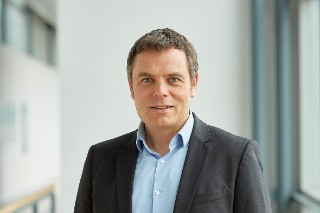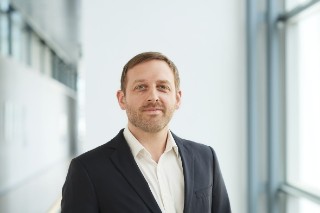Jahr
Year | Titel/Autor:in
Title/Author | Publikationstyp
Publication Type |
|---|
| 2023 |
Circular Economy als Basis für resiliente und erneuerbare Rohstoffkreisläufe
Brellochs, Jochen; Goy, Julia; Scherdel, Christian; Brödnerl, Romy; Nelles, Michael; Lorenz, Tom; Weiß, Karl-Anders; Kullmann, Felix; Wern, Bernhard; Tavakkol, Salar; Borchers, Malorzata; Otto, Danny; Berg, Holger |
Konferenzbeitrag
Conference Paper
|
| 2023 |
Der digitale Gebäudezwilling. Wie kann er zur energetischen Optimierung von Gebäuden beitragen?
Frison, Lilli; Réhault, Nicolas |
Zeitschriftenaufsatz
Journal Article
|
| 2023 |
Kernelemente einer erfolgreichen Wärmewende
Henning, Hans-Martin |
Vortrag
Presentation
|
| 2023 |
Transfer learning methodology for machine learning based fault detection and diagnostics applied to building services
Réhault, Nicolas; Rist, Tim; Chavan, Kunal |
Zeitschriftenaufsatz
Journal Article
|
| 2023 |
Zyklische Wasserverdampfer für Adsorptionskälteanlagen - Herausforderungen eines vereisenden Betriebs
Volmer, Rahel; Nonnen, Thomas; Da Silva Moreira, Adrian; Füldner, Gerrit; Schnabel, Lena; Herrmann, Ralph |
Konferenzbeitrag
Conference Paper
|
| 2023 |
Grüne Wärmetransformation - Anforderungen und Technologien
Herkel, Sebastian |
Vortrag
Presentation
|
| 2023 |
Evaluating Different Artificial Neural Network Approaches for Forecasting Heat Demand in District Heating Networks
Bitterling, Moritz; Gölzhäuser, Simon; Frison, Lilli; Kramer, Wolfgang |
Vortrag
Presentation
|
| 2023 |
Comparison of different deep neural networks for system identification of thermal building behavior
Gölzhäuser, Simon; Frison, Lilli |
Zeitschriftenaufsatz
Journal Article
|
| 2022 |
EnWiSol_II - Solarthermie in der städtischen Energieversorgung - Gesamtvorhaben -. Abschlussbericht
Oliva, Axel; Herkel, Sebastian; Frison, Lilli; Scharf, Katrin; Kaupenjohann, Lukas; Ripka, Alexander |
Bericht
Report
|
| 2022 |
FIHLS Fassaden integrierte Heizung + Kühlung, Lüftung und Sanitär. Schlussbericht
Dinkel, Arnulf; Carbonare, Nicolas; Ziemer, Sabastian; Krüger, Michael; Gliem, Stefanie; Liedloff, Frank; Knospe, Olaf; Schelp, Hans; Fonfara, Harald; Wyrobek, Michael; Blab, Reinhard; Pflug, Thibault |
Bericht
Report
|
| 2022 |
Methode für eine integrale digitale Repräsentation der technischen Gebäudeausrüstung mit Schwerpunkt auf der Beschreibung der Regelung
Ihlenburg, Moritz; Benndorf, Gesa; Réhault, Nicolas |
Konferenzbeitrag
Conference Paper
|
| 2022 |
Automatisierte Generierung von digitalen Anlagenschemata
Mattmüller, Jan; Benndorf, Gesa; Preintner, Peter |
Konferenzbeitrag
Conference Paper
|
| 2022 |
Zweijahresgutachten 2022
Henning, Hans-Martin; Knopf, Brigitte; Bettzüge, Marc O.; Heimer, Thomas; Schlomann, Barbara |
Bericht
Report
|
| 2022 |
A mobile measurement solution for fault detection and diagnosis in buildings
Rist, Tim; Ihlenburg, Moritz; Réhault, Nicolas |
Konferenzbeitrag
Conference Paper
|
| 2022 |
Der Gebäudesektor im Kontext der Energie- und Klimapolitik
Henning, Hans-Martin |
Vortrag
Presentation
|
| 2022 |
Simulationen und Messungen im Kontext von TABSOLAR®-Systemen
Mattmüller, Jan; Sporrer, Heike |
Vortrag
Presentation
|
| 2022 |
Softwareunabhängig-verlustfreie Projektdatenumgebung und föderal-selbstbeschreibende parametrische Modellierung multifunktionaler Bauprodukte auf Basis des Semantic Web mit Fokus auf die Gebäudehülle. Schlussbericht
Maurer, Christoph; Rist, Tim; Kuhn, Tilmann; Shi, Meiling; Huyeng, Tim-Jonathan; Hoffmann, André; Thiele, Christian-Dominik; Rüppel, Uwe; Sprenger, Wendelin |
Bericht
Report
|
| 2022 |
Die Energiewende im Gebäudesektor - aktuelle Entwicklungen aus der Forschung
Henning, Hans-Martin |
Vortrag
Presentation
|
| 2021 |
MoTive - Interaktives Werkzeug zur BIM-basierten Unterstützung eines technischen Monitorings nach AMEV
Benndorf, Gesa; Ihlenburg, Moritz; Réhault, Nicolas |
Zeitschriftenaufsatz
Journal Article
|
| 2021 |
MPC for collaborative heat transfer in a district heating network with distributed renewable energy generation and storage
Frison, Lilli; Oliva, Axel; Herkel, Sebastian |
Konferenzbeitrag
Conference Paper
|
| 2021 |
Optimierte Regelung von thermisch getriebenen Kühlsystemen - Simulation und Praxistest
Nienborg, Björn; Singler, J.; Gührlich, D.; Dalibard, Antoine |
Aufsatz in Buch
Book Article
|
| 2021 |
Model-Based Evaluation of Air-Side Fouling in Closed-Circuit Cooling Towers
Nienborg, Björn; Mathieu, M.; Schwärzler, A.; Conzelmann, K.; Schnabel, Lena |
Zeitschriftenaufsatz
Journal Article
|
| 2020 |
Schallimmissionen von Luftwärmepumpen. Methodik zur und erste Ergebnisse einer Langzeitmessung im Feld
Nienborg, B.; Oltersdorf, T.; Günther, D.; Henninger, S.; Müller, M.; Rollwage, C. |
Vortrag
Presentation
|
| 2020 |
Measurement Results of a District Heating System with Decentralized Incorporated Solar Thermal Energy for an Energy, Cost Effective and Electricity Grid Favorable Intermitting Operation
Oliva, Axel; Kim, Y.; Lämmle, Manuel; Herkel, Sebastian; Ripka, A.; Gebele, C. |
Konferenzbeitrag
Conference Paper
|
| 2020 |
Campusweites Kältenetz für Höhere Effizienz und Netzdienlichkeit
Nienborg, Björn; Notheis, Moritz; Kurzlechner, Philipp; Seiz, Jana; Engelmann, Peter |
Vortrag
Presentation
|
| 2020 |
Simulation with qualitative models in reduced tensor representations
Müller-Eping, Thorsten; Lichtenberg, Gerwald |
Zeitschriftenaufsatz
Journal Article
|
| 2019 |
Decentralized Fault Detection in Building Services by Means of Tensor Decomposed Qualitative Models
Müller-Eping, Thorsten; Réhault, Nicolas; Rist, Tim |
Zeitschriftenaufsatz
Journal Article
|
| 2019 |
Behaglichkeit und Co-Benefits von Nullenergiegebäuden - eine Lebenszyklusbetrachtung. Erste Ansätze zur monetären Quantifizierung von Co-Benefits
Köhler, B.; Berggren, B.; Togerö, Å. |
Vortrag
Presentation
|
| 2019 |
D5.2: Existing nZEB Business Models
Dinkel, Arnulf; Köhler, Benjamin; Quast, Anneke; Kießling, Lea; Andaloro, Annalisa; Köhler, Gerold; Stöcker, Thomas; Foletti, Cristina; Matricardi, Francesco; Torriglia, Davide; Knotzer, Armin |
Bericht
Report
|
| 2019 |
Life Cycle Cost Reduction and Market Acceleration for New Nearly Zero-energy Buildings
Weiß, T.; Pernetti, R.; Garzia, F.; Köhler, B.; Stobbe, Marc; Meier, K.; Berggren, B. |
Konferenzbeitrag
Conference Paper
|
| 2019 |
EnWiSol. Solarthermie in der städtischen Energieversorgung - Energiewirtschaftliche Analyse und Demonstrationsvorhaben "Freiburg-Gutleutmatten". Gesamtvorhaben
Oliva, Axel; Herkel, Sebastian; Elci, Mehmet; Helmling, Sebastian; Wapler, Jeannette; Ripka, Alexander |
Bericht
Report
|
| 2019 |
Künstliche Intelligenz regelt Heizungsanlagen effizienter
Kramer, Wolfgang |
Zeitschriftenaufsatz
Journal Article
|
| 2019 |
Heizen mit künstlicher Intelligenz
Kramer, Wolfgang |
Zeitschriftenaufsatz
Journal Article
|
| 2019 |
Messtechnische Analysen aus der Inbetriebnahme der dezentral eingebunden Solarthermieanlagen im Demonstrationsvorhaben Freiburg-Gutleutmatten
Oliva, Axel |
Konferenzbeitrag
Conference Paper
|
| 2019 |
Effizientere solarthermische Heizungsanlagen durch Künstliche Intelligenz (KI)
Kramer, Wolfgang |
Konferenzbeitrag
Conference Paper
|
| 2018 |
SolConPro - Ganzheitliche Integration energetisch aktiver Fassadenkomponenten in Bauprozesse. Schlussbericht
Eisenlohr, Johannes; Benndorf, Gesa; Sprenger, Wendelin; Wengzinek, Julian; Ghebrehiwet, Dawit; Wagner, Anna; Maurer, Christoph; Möller, Laura Kristina; Eller, Christian; Leifgen, Christian; Rüppel, Uwe; Kuhn, Tilmann |
Bericht
Report
|
| 2017 |
Netzreaktive Gebäude - Ganzheitliche Bewertung von Bauphysik und Gebäudeenergiesystemen einschliesslich ihrer Rolle in der Energiewirtschaft: Energie, Exergie, Leistungsbezug und -abgabe. Abschlussbericht 2017
Kalz, Doreen; Klein, Konstantin |
Bericht
Report
|
| 2017 |
Fault Detection Algorithms based on Decomposed Tensor Representations for Qualitative Models
Müller-Eping, Thorsten; Lichtenberg, Gerwald; Vogelmann, Vivien |
Zeitschriftenaufsatz
Journal Article
|
| 2016 |
Performance von Gebäuden. Kriterien, Konzepte, Erfahrungen
| Sammelband
Anthology
|


